You are using an out of date browser. It may not display this or other websites correctly.
You should upgrade or use an alternative browser.
You should upgrade or use an alternative browser.
A Table Engine Tale
- Thread starter Ramon
- Start date

Help Support Home Model Engine Machinist Forum:
This site may earn a commission from merchant affiliate
links, including eBay, Amazon, and others.
Good to see you back in the workshop and posting again Ramon. Plan to do the base for the Benso this weekend so we are at a similar stage.
J
J
AussieJimG
Well-Known Member
- Joined
- Oct 17, 2010
- Messages
- 890
- Reaction score
- 118
Welcome back Ramon, it's good to know that you are on the mend.
And my lessons continue - this time about painting. I realised how far behind I am when I read that you finish rubbing down the undercoat with a microfibre cloth. I do know that the quality of the finish depends mostly on the preparation but I had never thought to go to those lengths.
Thank you
Jim
And my lessons continue - this time about painting. I realised how far behind I am when I read that you finish rubbing down the undercoat with a microfibre cloth. I do know that the quality of the finish depends mostly on the preparation but I had never thought to go to those lengths.
Thank you
Jim
Don1966
Senior Member
- Joined
- Jan 19, 2012
- Messages
- 487
- Reaction score
- 24
Welcome back Ramon, :big: I am glad to see the lessons continue. You just keep amazing me with your skills and professionalism. You should be writing a book on what you know. The Shop wisdom of Ramon series and I really mean that with a good heart. I would buy your first book. Please stay healthy and continue your thread. I want to see your engine run.
Kind Regards Don
Kind Regards Don

$99.99
AHS Outdoor Wood Boiler Yearly Maintenance Kit with Water Treatment - ProTech 300 & Test Kit
Alternative Heating & Supplies

$26.89
$34.99
Peachtree Woodworking Supply Bowl Sander Tool Kit w/Dual Bearing Head & Hardwood Handle, 42 Pieces Wood Sander Set, 2 Hook & Loop Sanding Disc Sandpaper Assortment, 1/4 Mandrel Bowl Sander
Peachtree Woodworking Supply Inc

$49.95
$55.99
DjuiinoStar Hot Air Stirling Engine Assembly Kit: Spend 30 Minutes to Build Your Own Stirling Engine
djuiinostar

$45.99
Sunnytech Mini Hot Air Stirling Engine Motor Model Educational Toy Kits Electricity HA001
stirlingtechonline

$19.15
$29.95
Competition Engine Building: Advanced Engine Design and Assembly Techniques (Pro Series)
MBC Inc.

$180.58
Replacement For/Fits A152179 Tractor Water Pump Fits 770 870 970 1070
Astra Tech Global Corp

$599.00
$649.00
FoxAlien Masuter Pro CNC Router Machine, Upgraded 3-Axis Engraving All-Metal Milling Machine for Wood Acrylic MDF Nylon Carving Cutting
FoxAlien Official
Welcome back Ramon.
Regarding the masking, I found some masking tape that has a barrier that is activated by the paint to stop paint from bleeding under the edge of the tape. Found out about it on a home improvement site. I's called "Frog" tape and is green. I got it at Lowes. Masked off and repainted my stairs and was amazed at how clean the edges were when I took the tape off. Worked excellent with Latex paint. I haven't tried anything else yet.
Ron
Regarding the masking, I found some masking tape that has a barrier that is activated by the paint to stop paint from bleeding under the edge of the tape. Found out about it on a home improvement site. I's called "Frog" tape and is green. I got it at Lowes. Masked off and repainted my stairs and was amazed at how clean the edges were when I took the tape off. Worked excellent with Latex paint. I haven't tried anything else yet.
Ron
ref1ection
Well-Known Member
- Joined
- Nov 18, 2009
- Messages
- 83
- Reaction score
- 1
Good to see you back in the shop Ramon and on the mend. There's still many days of updates left on this one and then we get to watch your next project take shape. 
Ray
Ray
- Joined
- Jan 30, 2011
- Messages
- 365
- Reaction score
- 72
Hi Guy's just a small update - I'm afraid theres not much progress watching paint dry : .
.
But first my thanks as usual for your response ...
Looking forward to seeing the Benson up and running Jason - looks like you will be ahead of me by a couple of weeks, you are so close to the end too.
Don 1966 - That's a very nice thing to say and I'm touched by your confidence :-[. I'm afraid though I don't see myself in quite the same way, just someone doing what he loves and passing it on to those who may gain some benefit and hopefully, by input from others, learn something myself.
Ozzie - Thanks for the tip - I have read of 'Frog' tape but have as yet to see any.
I should perhaps have made it a little clearer re masking that when masking something up like these parts I find it's fine to use conventional, household masking tape to mask unpainted areas but where there are previously painted areas to mask then a much thinner, lower tack tape would be used. The very best I have used for this purpose is what was called 'Betto' tape. This was a tan coloured tape, very thin and capable of being cut into extremely thin strips without disintegrating. It was replaced by a white coloured tape - still with the same name but nowhere as good as the tan stuff. A good alternative is 'Tamiya' tape. This yellow coloured tape can be cut similarly but doesn't quite have the strength as the original Betto. It's readily available at most model shops though and if bought in the 40mm wide roll as opposed to the narrower rolls in dispensers is very economical.
One little tip on masking that some may find useful. Instead of using news paper or similar to mask out areas from over spray consider using ordinary kitchen tinfoil. This is totally impervious to the solvents and is easilly wrapped around any shape with ease. Make sure you buy your own though
Whilst it was intended to edge the flywheel pit with 'bricks' as mentioned on the last post no real thought had been given as to what to make them from. After a fair bit of poking around under the bench for something suitable it occurred that perhaps they could be made from MDF board which is what was used for the 'stone' plinth. The edge of a piece of board was sanded to a suitable section on the two 'as seen' faces then cut off on the band saw. Treated gently as it easily snaps in thin sections the inner face was sanded smooth then the strips sealed using very thin cellulose 'Sanding Sealer'. This was then cut into brick sized lengths which were milled to length to give a good uniform fit in the rebate
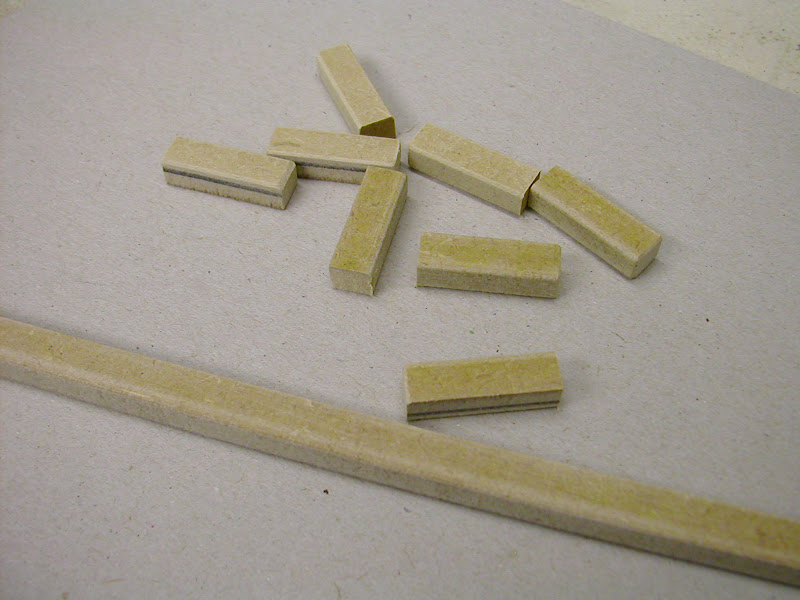
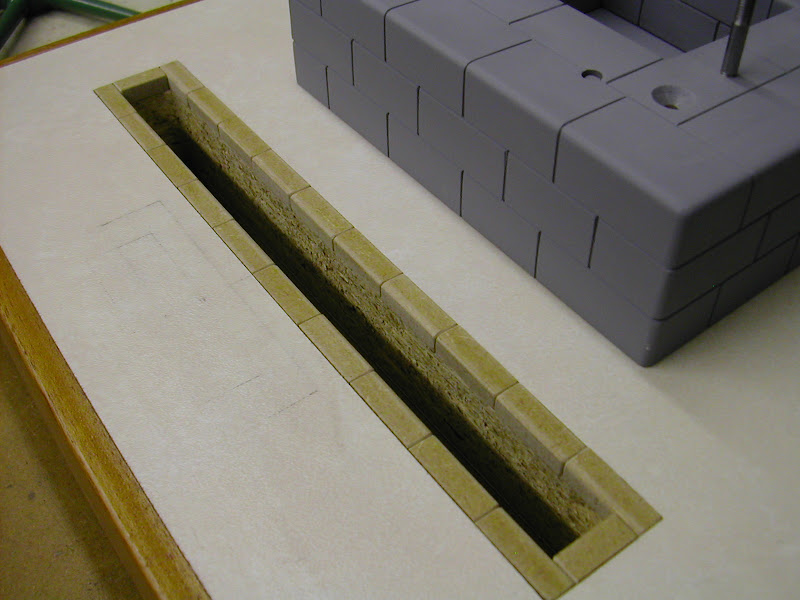
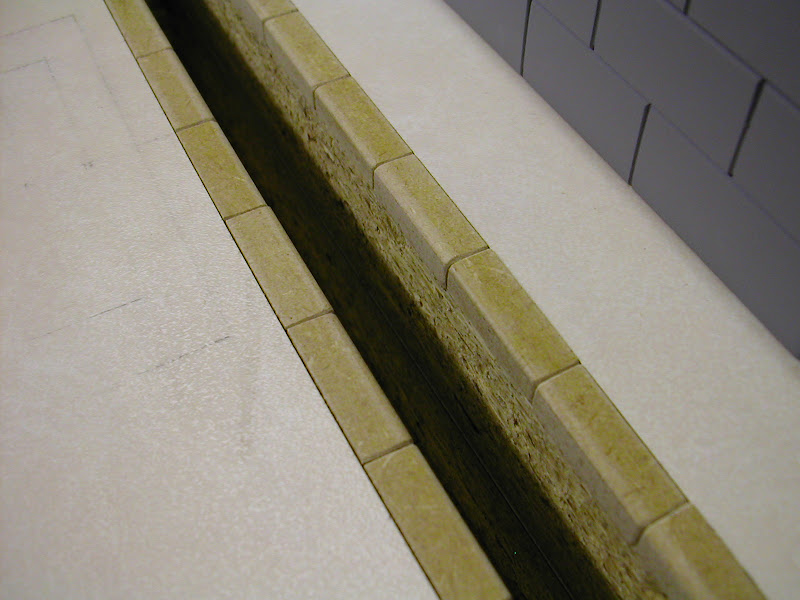
Once dry fitted they were removed and all given a second coat of sealer before being painted and left ready to fit using PVA glue.
The first hint of a warm day and it was time for the top coat. All painting was done using aerosols. Priming including the plinth used about two and a half 300ml cans and the two topcoats just under two cans of the same size
Again, some masking utilised the parts themselves.. the bearings will be washed in cellulose thinner to remove the paint
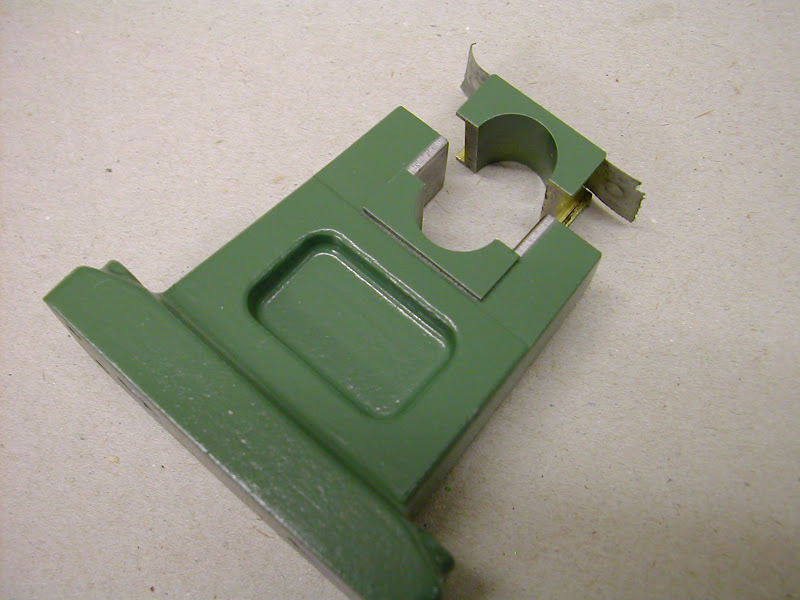
Taken tonight, this is where patience will be sorely tried as though touch dry they need to harden off for at least a couple of days before reassembly. The keen eyed might note that 3-2-1 blocks truly are versatile
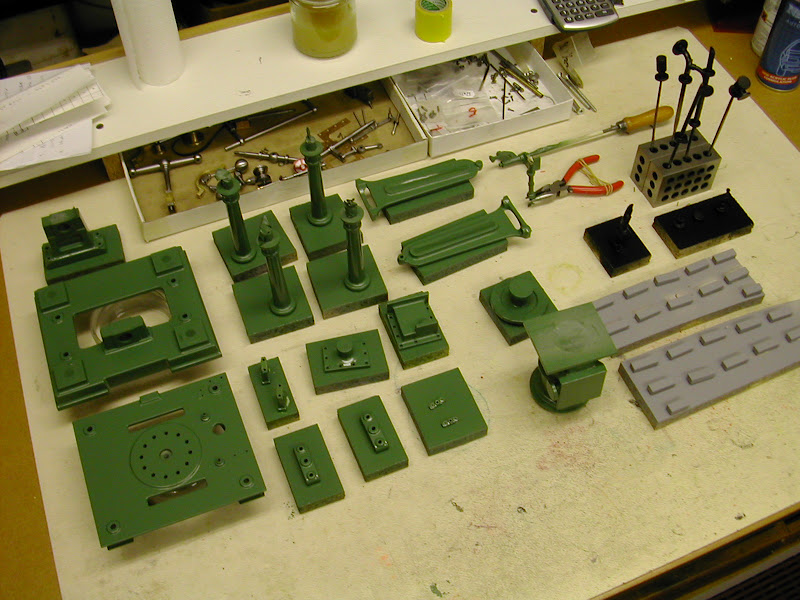
The base as finished and ready to fit those 'bricks' tomorrow

The plinth, three layers of 18mm MDF board is very solid, no glue just four screws hold the layers together. The grooves were cut using a hand saw against a straight edge. Pleased with the colour of the primer the surface will be oiled and left as is. The out rigger bearing plinth has yet to be made as it's thickness will need to be ascertained after the engine is securely bolted in position
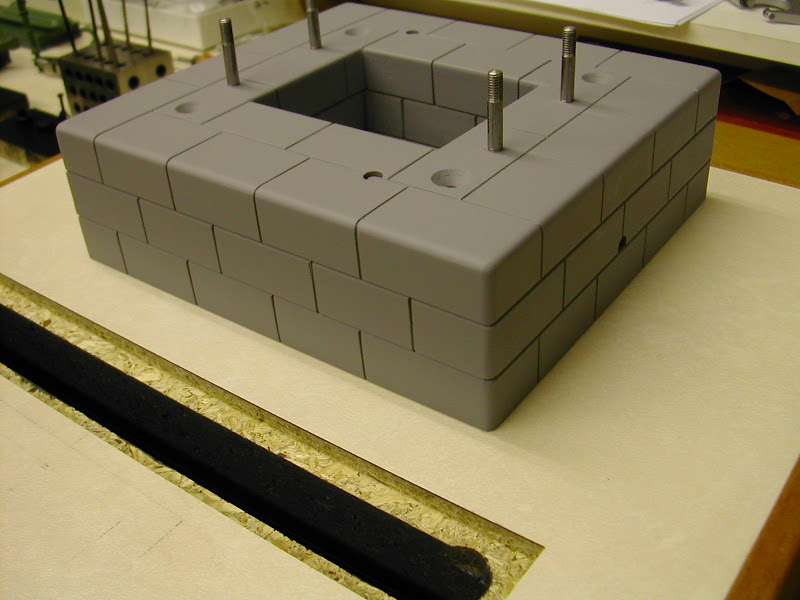
Well another small step, but getting closer. The interim time has been spent on drawing out a new I/C engine but more on that later
Regards for now - Ramon
But first my thanks as usual for your response ...
Looking forward to seeing the Benson up and running Jason - looks like you will be ahead of me by a couple of weeks, you are so close to the end too.
Don 1966 - That's a very nice thing to say and I'm touched by your confidence :-[. I'm afraid though I don't see myself in quite the same way, just someone doing what he loves and passing it on to those who may gain some benefit and hopefully, by input from others, learn something myself.
Ozzie - Thanks for the tip - I have read of 'Frog' tape but have as yet to see any.
I should perhaps have made it a little clearer re masking that when masking something up like these parts I find it's fine to use conventional, household masking tape to mask unpainted areas but where there are previously painted areas to mask then a much thinner, lower tack tape would be used. The very best I have used for this purpose is what was called 'Betto' tape. This was a tan coloured tape, very thin and capable of being cut into extremely thin strips without disintegrating. It was replaced by a white coloured tape - still with the same name but nowhere as good as the tan stuff. A good alternative is 'Tamiya' tape. This yellow coloured tape can be cut similarly but doesn't quite have the strength as the original Betto. It's readily available at most model shops though and if bought in the 40mm wide roll as opposed to the narrower rolls in dispensers is very economical.
One little tip on masking that some may find useful. Instead of using news paper or similar to mask out areas from over spray consider using ordinary kitchen tinfoil. This is totally impervious to the solvents and is easilly wrapped around any shape with ease. Make sure you buy your own though
Whilst it was intended to edge the flywheel pit with 'bricks' as mentioned on the last post no real thought had been given as to what to make them from. After a fair bit of poking around under the bench for something suitable it occurred that perhaps they could be made from MDF board which is what was used for the 'stone' plinth. The edge of a piece of board was sanded to a suitable section on the two 'as seen' faces then cut off on the band saw. Treated gently as it easily snaps in thin sections the inner face was sanded smooth then the strips sealed using very thin cellulose 'Sanding Sealer'. This was then cut into brick sized lengths which were milled to length to give a good uniform fit in the rebate



Once dry fitted they were removed and all given a second coat of sealer before being painted and left ready to fit using PVA glue.
The first hint of a warm day and it was time for the top coat. All painting was done using aerosols. Priming including the plinth used about two and a half 300ml cans and the two topcoats just under two cans of the same size
Again, some masking utilised the parts themselves.. the bearings will be washed in cellulose thinner to remove the paint

Taken tonight, this is where patience will be sorely tried as though touch dry they need to harden off for at least a couple of days before reassembly. The keen eyed might note that 3-2-1 blocks truly are versatile

The base as finished and ready to fit those 'bricks' tomorrow

The plinth, three layers of 18mm MDF board is very solid, no glue just four screws hold the layers together. The grooves were cut using a hand saw against a straight edge. Pleased with the colour of the primer the surface will be oiled and left as is. The out rigger bearing plinth has yet to be made as it's thickness will need to be ascertained after the engine is securely bolted in position

Well another small step, but getting closer. The interim time has been spent on drawing out a new I/C engine but more on that later
Regards for now - Ramon
Don1966
Senior Member
- Joined
- Jan 19, 2012
- Messages
- 487
- Reaction score
- 24
Ramon glad to see back :bow: great work, you are getting so close to finishing. I am just like a little kid and very anxious to see the completed engine. Your paint job has taught me things I would of never thought of, your talents keeps us searching for your new post.
Regards Don
Regards Don
ref1ection
Well-Known Member
- Joined
- Nov 18, 2009
- Messages
- 83
- Reaction score
- 1
Looking great Ramon. Really interesting to see your use materials for the stonework. Also, I'm glad to hear you have another one in the works.
Ray
Ray
- Joined
- Jan 30, 2011
- Messages
- 365
- Reaction score
- 72
Well, the old patience finally ran out this morning :
Any way here's how it stands at end of play today - should give you an idea of how it will look - hopefully it will be finished this week all being well. ;D
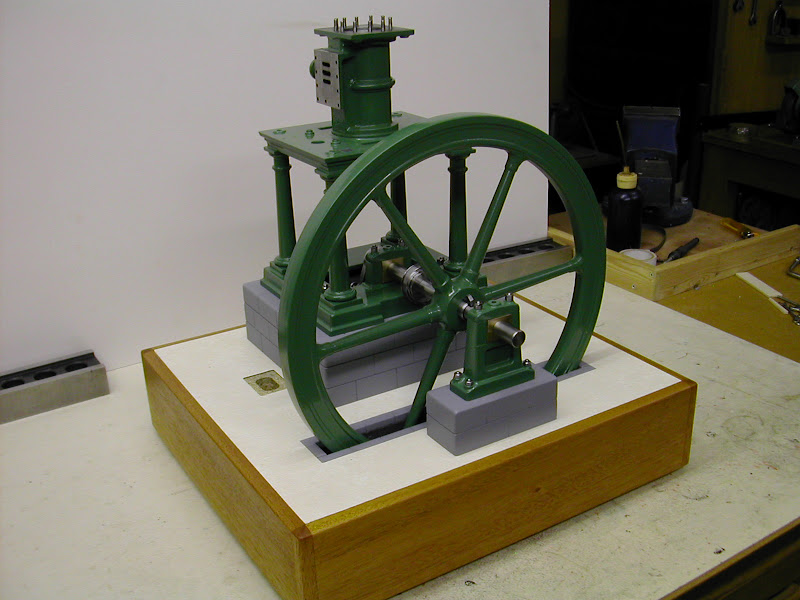
That's all for now - back in a day or two
Regards - Ramon
AussieJimG
Well-Known Member
- Joined
- Oct 17, 2010
- Messages
- 890
- Reaction score
- 118
It is certainly living up to expectations. What a lovely job.
Jim
Jim
Harold Lee
Well-Known Member
- Joined
- Apr 23, 2008
- Messages
- 236
- Reaction score
- 2
Ramon - Your workmanship is just astounding.... This project is almost beyond words.... Keep up the good work and it is good to have you working on it again.
Harold
Harold
Ramon are you leaving the base as white melamine or going to apply a tile/stone finish?
Its comming along well.
J
Its comming along well.
J
- Joined
- Jan 30, 2011
- Messages
- 365
- Reaction score
- 72
'Morning Jason, Actually its not white melamine though it certainly looks like it in the pic. The colour is a very light tan and yes I have decided to leave it as such. I was going to paint it the usual (for me) rusty red that previous bases have been painted but I felt that might clash a bit besides - the 'govenor' likes it and it is for her after all 
Ramon
Ramon
Similar threads
- Replies
- 28
- Views
- 3K
- Replies
- 19
- Views
- 5K

















































